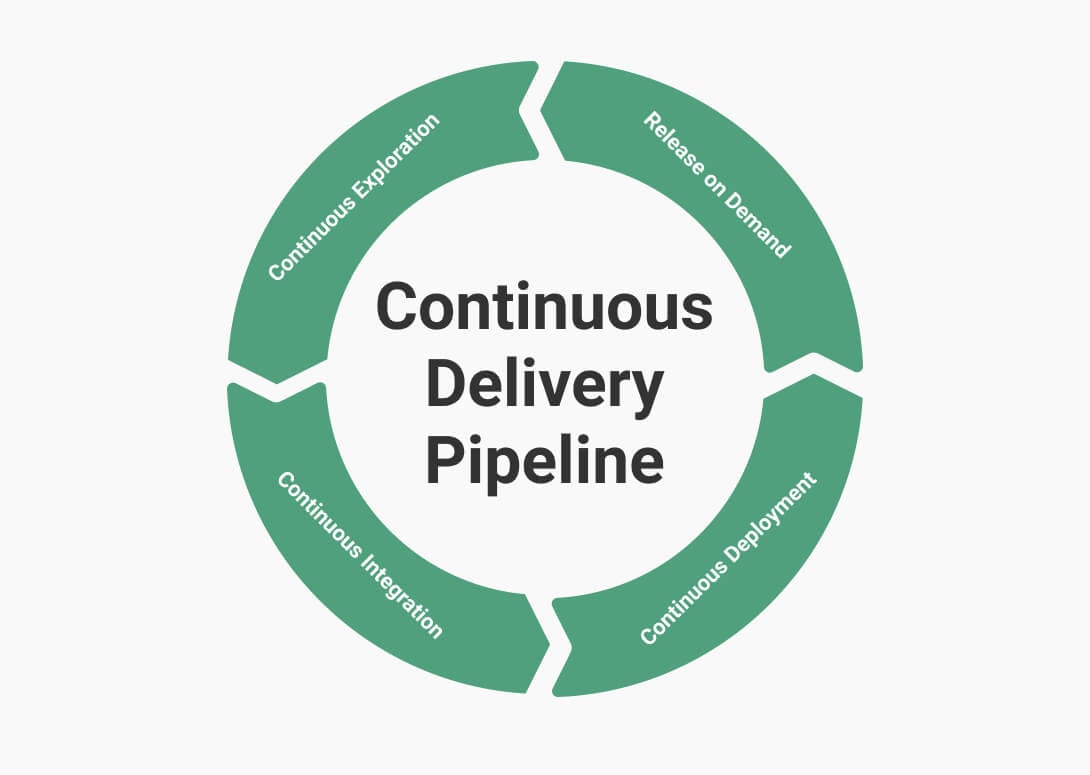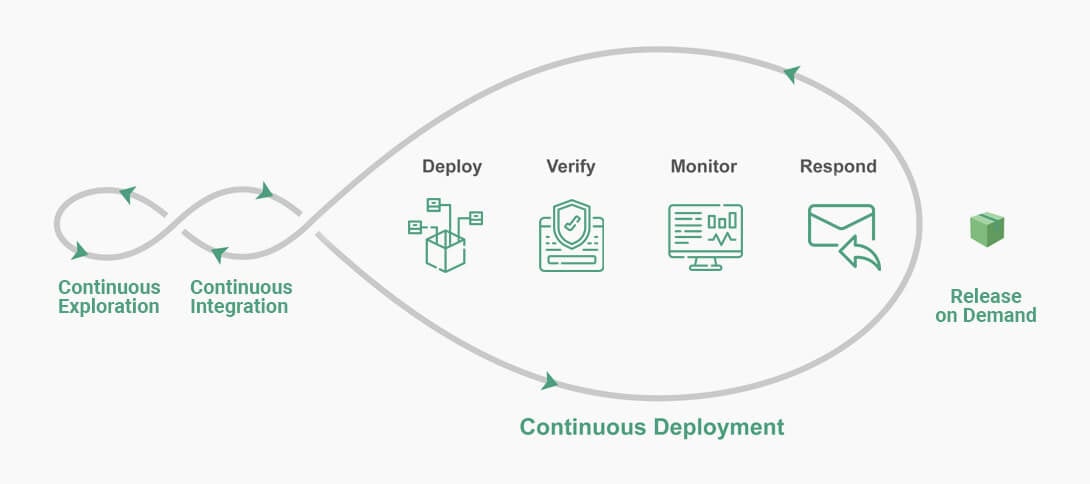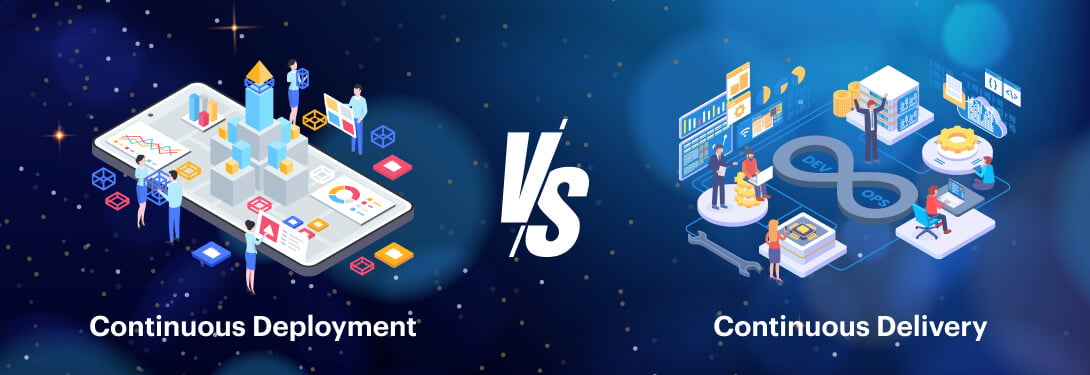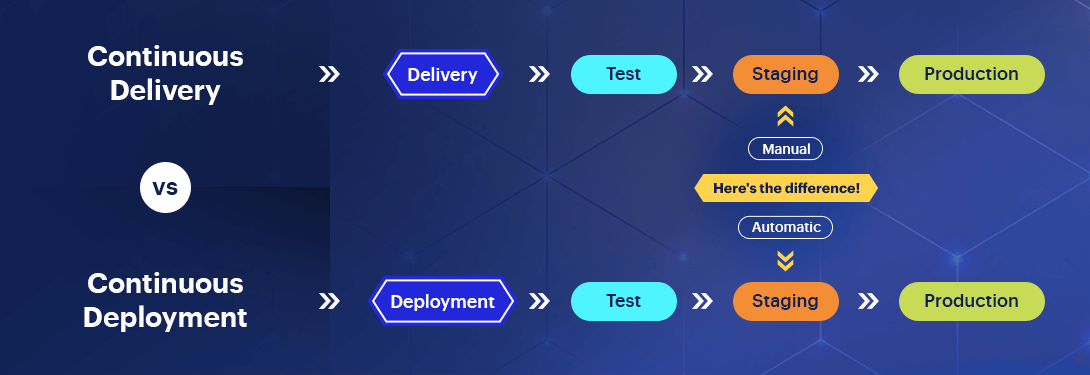DevOps has gained significant traction over the period. As per a report by Research and Markets, the global DevOps market shall touch the value of US $12.25 billion by the end of 2026 with an enormous 18.95% CAGR. It is also noticeable that the market was hovering over the US $5.11 billion in 2021. As we know, DevOps is a combination of six cultural philosophies, practices, and tools that increases an organization’s ability to produce products and services at a higher pace. These practices are continuous planning, continuous development, continuous integration, continuous deployment, continuous testing, and continuous monitoring.
However, among these six practices, one set of principles is gaining massive momentum today -Continuous Deployment. So what is continuous deployment? Let’s find out! Why is it gaining so much popularity in software development?
Expand your business with our offshore resources
What is Continuous Deployment?
Continuous Deployment or CD is a software release process that utilizes automated testing to authenticate the changes in the codebase. Continuous deployment also ensures that the changes made in the codebase are stable for immediate autonomous deployment to a productive environment.
Over time the software release cycle has evolved. The legacy process of transferring code and monitoring is error-prone and consumes heavy resources. Continuous deployment and its tools can automate the entire deployment process allowing developers to focus on core business requirements rather than infrastructure overheads.

Continuous deployment is the third stage in the four-part continuous delivery pipeline. Whereas, the other three parts are continuous exploration, integration, and demand release. The continuous delivery pipeline is an integral part of DevOps, ensuring the optimum synchronization between development and operation teams in an organization.
It is very critical for organizations to possess the ability to release the product or updates on demand. It is a significant factor that enhances Agile Release Train or ART competency. Release on Demand allows enterprises to respond to the market opportunities with value-adding solutions in the shortest period and at a rate to absorb customer functionality.
Products, features, or updates must have authentic verification before their implementation in the production environment to deliver as per business demands. Hence developers must separate the deployment process from the release process. As a result, the deployed changes can smoothly move to the production environment and does not affect the behavior of the current system. The entire process allows the development teams to continually make more minor and incremental changes to the system. However, these updates are not released to end-users until the time is right.
How does Continuous Deployment work?

Since we know that continuous deployment is, let’s try to figure out how continuous deployment works? What are the stages of continuous deployment? And, what impact does it have on the final product deployed in the production environment?
The 4 stages of continuous deployment are:
- Deploy
- Verify
- Monitor
- Respond
1. Deploy
Deployment in DevOps is the migration of changes into the production environment. In the continuous delivery pipeline, the deployment of updates happens continuously. Thus, partial functionality or deploying some of the stories that comprise a feature can be implemented into production.
Let’s understand this with a simple example. Consider a user story map in which an update of X number of features. These features will be coded, implemented, and deployed in large batches. Continuous deployment in DevOps allows the software developers to deploy each component individually to be verified, monitored, and cued in a simulated production environment. Once all the features are tested and deployed, the client can release them to its users.
Typically, the deployment pipeline triggers the process automatically, resulting in a successful build, integration, and validation. As a result, this makes the entire workflow a fully-automated “one-click” process.
There are seven best practices for a seamless deployment stage:
Dark launches
Dark launches provide the ability to deploy the update or product to the production environment without releasing the functionality to the end-users.
Feature toggles
It is a technique that DevOps developers use to facilitate dark launches by implementing toggles in the code. This enables switching between the old and new functionality of the feature.
Deployment automation
It can deploy a tested solution automatically from check-in to production.
Selective deployment
Selective deployment allows the developer to deploy specific production environments based on the criteria such as geography, user-role, Etc.
Self-service deployment
In the absence of automation deployment, self-service deployment allows a single command to take solutions from staging to production.
Version control
It allows developers to maintain environments under version control to enable fast deployment and recovery.
Blue/green deployment
The practice permits on-demand switching between staging and production environments.
2. Verify
Before releasing the final product to end-users, the deployment must be verified for its integrity and functional robustness. When coupled, deployment and release happen almost instantaneously, and decisions must be taken immediately about the rollbacks. However, there is room for extensive new functionality tests when decoupled before approving it for release. Almost immediately, once the migration is complete, the code for new updates goes for a final round of testing in continuous deployment. Typically, this is conducted by performance tests, smoke testing, and light user acceptance testing. As a result, this provides a necessary quality check that tests the behavior of the solution in an actual production environment.
3. Monitor
Verifying the deployed features is essential in the continuous deployment, and it happens autonomously in the continuous delivery pipeline. However, it’s always a good practice to have a vigilant set of eyes to monitor the feature’s performance and value over its lifespan. The process that drives this critical feedback loop is achieved by robust monitoring capabilities.
Proficient monitoring requires full-stack telemetry for all features deployed during continuous deployment. Moreover, this ensures that the system performance, incidents, and business values are determined swiftly and precisely in production.
4. Respond
The final stage is responding to the feedback provided during the verification, monitoring, and deployment stages. Nevertheless, the ability to respond and recover from unseen production issues is critical to support continuous deployment and streamline the continuous delivery pipeline.
Continuous Deployment vs Continuous Delivery

Most of the time, the terms continuous delivery and deployment are used interchangeably. However, that’s not true. Let’s focus on key differences between continuous deployment and continuous delivery:

| Continuous Deployment | Continuous Delivery |
| Continuous deployment is an approach to obtain changes of new features, configuration, and bug fixes. | Continuous delivery is an approach to deliver software updates and features in a short cycle. |
| Continuous deployment implies automated implementations of the source code. | It refers to the logical evolution of continuous integration. |
| Continuous deployment focuses on the change in all stages of the client’s production pipeline. | Continuous delivery focuses on releasing new changes and updates to the client’s environment. |
| The developers deploy the code directly to the production stage when it is developed. | In continuous delivery, developed code is continuously delivered until the programmer considers it is ready to launch. |
| Continuous deployment enables you to rapidly deploy and validate new features and ideas. | Continuous delivery allows developers to check software updates. |
Advantages of continuous deployment
Since we know the difference between the two terms, let’s look at some of the advantages of continuous deployment in the software development life cycle.
Low-risk release
Blue/green deployments allow for lesser downtime of the update. Since continuous deployment does not allow the update to reach the end-users, rolling back to previous releases is comparatively easy and hassle-free.
Faster development
Continuous deployment does not hamper the development process as the process is automated. Therefore the coding process runs smoothly at the back-end, enhancing development speed.
Optimal time utilization
Automated deployment assists the team to reprioritize tasks continuously and focus on other tasks than investing time in manual deployment.
Improved tracking and visibility
It becomes much easier to measure the progress of the release when it is broken down into smaller chunks of codes that are continuously deployed. Moreover, continuous deployment provides the capability of continuous improvements to the developers, which are visible to customers making it easier for the developers to keep track of progress.
Popular continuous deployment tools
Looking at the advantages of continuous deployment, it is visible that software development giants dominate the continuous deployment market. But, which tools are optimal for a client’s production environment? Let’s try to find out:
AWS CodeDeploy
CodeDeploy is an AWS continuous deployment tool that helps businesses with application deployment to EC2 instances. It also helps the developers to deploy on-premises instances, serverless Lambda functions, and Amazon ECS services. AWS CodeDeploy offers features such as reduced downtime, automated instance deployment, ease of adoption, and centralized control. AWS CodeDeploy works best for startup projects and can help new companies to deliver the final product swiftly and with fewer errors and bugs.
Jenkins
Jenkins is a free and open-source continuous deployment tool that will automate the process of building, testing, and deploying the software. The platform supports Windows, Mac, and other UNIX-like operating systems. Moreover, it will work as a simple continuous integration server and a continuous delivery hub.
GitLab
With the help of GitLab continuous deployment tools, developers can build, test, deploy, and monitor the code in a single workflow. During the continuous deployment process of the CI/CD pipeline, it can quickly detect errors, ensuring the quality of the product is intact. The tool also helps the developers minimize the integration problems and compounding problems. GitLab is most effective when used to deploy services such as Kubernetes and application that needs to be deployed on multiple platforms.
Google Cloud Deployment Manager
Google Cloud Deployment Manager helps developers create and manage cloud resources using simple templates. The platform also allows the developers to treat their configuration as code and do repeatable deployments.
Conclusion
Continuous deployment is an effective practice that helps developers develop quality software. Nevertheless, the four stages of continuous deployment constantly add new features to an organization’s product and services. As a result, the delivery of the products is catching up with the pace, and with continuous deployment, they are now flexible enough to adopt new changes and updates.









